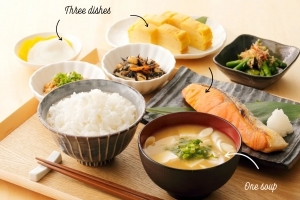Japanese table customs
Enjoying Japanese food begins, of course, with selecting the right ingredients. But around that, there are all sorts of customs that complete your Japanese dining experience. How do you set a table in Japanese style? What are the customs at the table and how do you actually put together a Japanese meal? In this blog, we tell you more about that.
Ichiju sansai
Basically, a traditional Japanese home meal follows the principle of ichiju sansai: one soup and three dishes. Dinner consists of, you guessed it, a bowl of miso soup, a fish or meat dish and two side dishes. Exactly what is served varies by season. The essential bowl of white rice does not count as one of the three dishes in ichiju sansai, but is a stand-alone element. The same goes for the table pickles.

Table arrangement
Just as we in Holland place the forks on the left and the knives on the right, there are rules for a traditional Japanese table arrangement.
- The chopsticks are at the front with the tip to the left.
- The bowl of rice is on the left and the soup on the right. Traditionally in Japan, the left is considered higher than the right. Rice was (and still is) offered to the gods and thus deserves an exalted place.
- The main course is on the back right and the side dishes on the left and center back.
Table manners in Japan
Before eating you say “Itadakimasu” (literally, “I receive”) and after eating “Gochisosama” (literally, it was a feast). With these expressions, you express gratitude to everyone who contributed to the dish on your table. From the farmer who grew the ingredients to the cook who prepared the dish. And from the fisherman who caught the fish to the fish that gave its life for it.
Expressing the beauty of nature and the changing seasons
Japanese cuisine uses many seasonal ingredients in each season. Enjoying the delicious ingredients of the four different seasons is one of the most enjoyable aspects of Japanese food. Examples of seasonal vegetables and fish are: bamboo shoots and wild vegetables in spring, summer vegetables and eel in summer, samphire and chestnuts in autumn, carrots and buri in winter.
Another characteristic of Japanese food is that you can enjoy the four seasons not only in taste but also in appearance. You can see the seasons in the use of natural ingredients such as flowers and leaves in dishes and in the type of tableware on which the dishes are served. For example, they use glassware to exude coolness in the summer and dark pottery for warmth in the winter.
We invite you try and make a ichiju sansai meal at home using local seasonal ingrediënts. Use our hokke recipe for inspiration!

